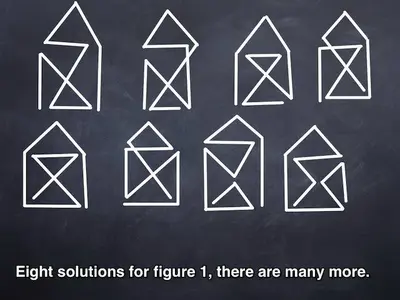twerppoet
iPad Fan
Seems selfish to solve puzzles, but not offer one, so:
An mild attack of insomnia led me to consider this common puzzle shown in figure 1. The idea is to draw it with one continuous line. Crossing lines is permitted, but retracing lines is not. If you've never seen it before, go ahead and solve it.
There are actually several solutions, I've worked out at least six; and that does not include mirror images and going backwards. In the process I noticed some interesting relationships, that on further thought made perfect sense. I've made kind of logic/geometry puzzle/quiz; so the sleepless hours were not completely waisted.
All solutions for figure 1 have one thing in common. What is it, and why?
Figure two has even more possible solutions, far too many for me to even bother working out. They also have one thing in common. What is it, and why?
If you've figured out the why answers to figure 1 and 2, then you should have no problem telling me why figure 3 has no solution.
View attachment 9162
Have fun.
Ok, I think it's been long enough. If you want to keep trying, stop reading here.
1: Every solution starts on one of the two bottom corners, and stops on the other. This is because those two points have an odd number of lines coming from them. The only way to create an odd number is to either stop the line there, or start it there.
2: Every solution ends at the starting point. Again, this is because you are drawing a single line. The figure only has points with an even number of lines coming from them. When you start a line it has an odd number of lines at that point. You must end the line there to make it even again.
3: This figure has four points where there are an odd number of lines meetings. The single line that you are drawing has only two end points, so you can only draw a figure with two odd junctions. You would have to lift your pen from the paper at least once to draw this figure.
Notes:
Another way of looking at this puzzle is as piece of string, wire, or straw that you can bend on a flat surface. When you look at it this way the two (and only two) end points become obvious, and your only two choices become obvious. Either the two ends meet and all points have an even number of lines leaving them, or they do not meet and there are two points with an odd number of lines leaving.
Once you realize that all solutions to figure 1 start and stop on the same two point it gets a lot easier to find those solutions.
When you realize that you can treat the x in the middle of the box as another point (instead of crossing lines), suddenly there are a 'lot' more solutions.
Unlike figure 1, you could start drawing figure 2 from the middle of a line. This means figure 2 has an infinite number of solutions. Even if you limit yourself to only starting where the lines meet, there are at least two solutions per point (probably more), adding up to a whole lot of solutions.
Here are some of the solutions for figure 1, just because.

Last edited:
